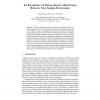Free Online Productivity Tools
i2Speak
i2Symbol
i2OCR
iTex2Img
iWeb2Print
iWeb2Shot
i2Type
iPdf2Split
iPdf2Merge
i2Bopomofo
i2Arabic
i2Style
i2Image
i2PDF
iLatex2Rtf
Sci2ools
ISVC
2007
Springer
2007
Springer
Iris Recognition: An Entropy-Based Coding Strategy Robust to Noisy Imaging Environments
Abstract. The iris is currently accepted as one of the most accurate traits for biometric purposes. However, for the sake of accuracy, iris recognition systems rely on good quality images and significantly deteriorate their results when images contain large noisy regions, either due to iris obstructions (eyelids or eyelashes) or reflections (specular or lighting). In this paper we propose an entropy-based iris coding strategy that constructs an unidimensional signal from overlapped angular patches of normalized iris images. Further, in the comparison between biometric signatures we exclusively take into account signatures’ segments of varying dimension. The hope is to avoid the comparison between components corrupted by noise and achieve accurate recognition, even on highly noisy images. Our experiments were performed in three widely used iris image databases (third version of CASIA, ICE and UBIRIS) and led us to observe that our proposal significantly decreases the error rates in...
| Added | 08 Jun 2010 |
| Updated | 08 Jun 2010 |
| Type | Conference |
| Year | 2007 |
| Where | ISVC |
| Authors | Hugo Proença, Luís A. Alexandre |
Comments (0)

